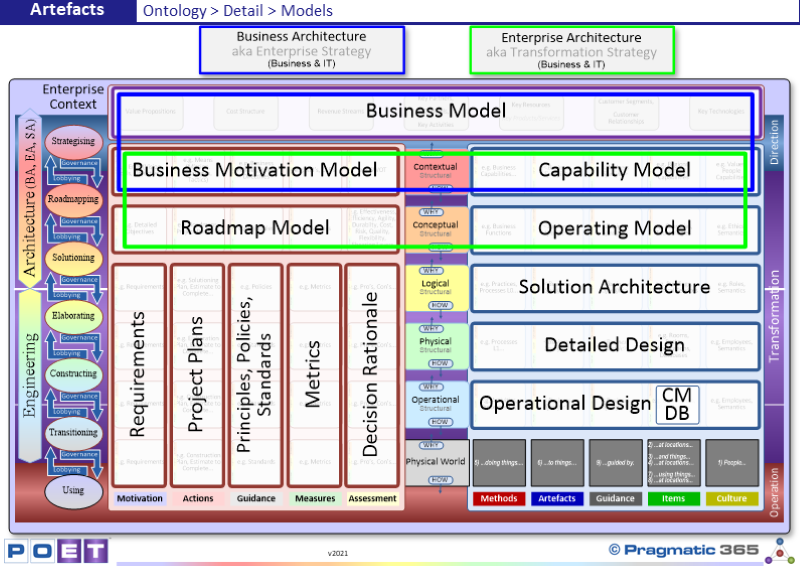|
| | | | | | | | | | | | | | | | | | | | | | | | | | | | | | | | | | | | | | | | | | | | | | | | | | | | | | | | | | | | | | | | | | | | | | | | | | | | | | | The Architecture Paradigm |
| | | | | | | | | | | | | | | | | | | Architecture and Engineering |
| | | | | | | | | | | | | | | | | | | | Culture Trumps Everything |
| | | | | | | | | | | | | | | | | | | | | | | | | | | | | | | | | | | | | | | | | |
|
|
|
|
| Click a Thumbnail to read the component. Hold down Ctrl while
clicking to expand the image |
Foundation - Certification Training 2 - Foundation
https://pragmatic365.org/display-show.asp?Showname=TRAIN-2-Foundation&ComponentNo=000464
Where does your Enterprise’s Business Model, Business Motivation Model, Capability Model, Roadmap and Operating Model fit into your Enterprises Transformation domain?
Do you have the required basic information, in a usable format, to allow your Enterprise to produce the Business Motivation Model and Operating Model?
Do you have the required basic information, in a usable format, to allow your Enterprise to produce the Roadmap and Operating models?
https://pragmatic365.org/display-show.asp?Showname=TRAIN-2-Foundation&ComponentNo=000464
FREE EA Training at www.PEAF.com/Training
FREE EA Books at www.PEAF.com/Books
#PEAF #PragmaticEA #EntArch #enterprisearchitecture #BizArch #Change #Innovation #BusinessModel #CEO #Strategy #TOGAF #ITgovernance #agileculture #agile #agileleadership #agilemethodology #itstrategy #ceos
Enterprise Strategy is the Business Motivation and Capability models, set in the context of the Business Model. Transformation Strategy is the Roadmap and Operating models, set in the context of the Capability and Business Motivation models’
https://pragmatic365.org/display-show.asp?Showname=TRAIN-2-Foundation&ComponentNo=000464

In order for people to understand POETs fundamental
structural and transformational ontology, here we map the names of common
documents/models/artefacts etc, that many people are familiar with (although
perhaps, not everyone defines them in the same way!)
Looking at the top of the diagram, this information
corresponds to what many people refer to as the Business Model. It corresponds
to the Enterprise Context level. Since this information is part of the
Direction Capability, the specific ontologies used are defined in POED. Any
metamodels actually used, can be very business dependant (and dependent upon
the C-Suite’s experience) but typically utilise things like the Business Model
Canvas (BMC) as illustrated here. ...to read more, please Login or Register |
Keypoint |
Adopt this component by... |
Enterprise Strategy is the Business Motivation and Capability models, set in the context of the Business Model. Transformation Strategy is the Roadmap and Operating models, set in the context of the Capability and Business Motivation models’
|
Management: Ensure that all parts of the Enterprise understand the dependencies between the Business model, the Business Motivation model, Capability models, Operating models and Roadmap models.
Management: Ensure that all parts of the Enterprise understand the dependencies between the Enterprise Strategy and Transformation Strategy.
|
Questions to ponder... |
Where does your Enterprise’s Business Model, Business Motivation Model, Capability Model, Roadmap and Operating Model fit into your Enterprises Transformation domain? | Do you have the required basic information, in a usable format, to allow your Enterprise to produce the Business Motivation Model and Operating Model? | Do you have the required basic information, in a usable format, to allow your Enterprise to produce the Roadmap and Operating models? |
|